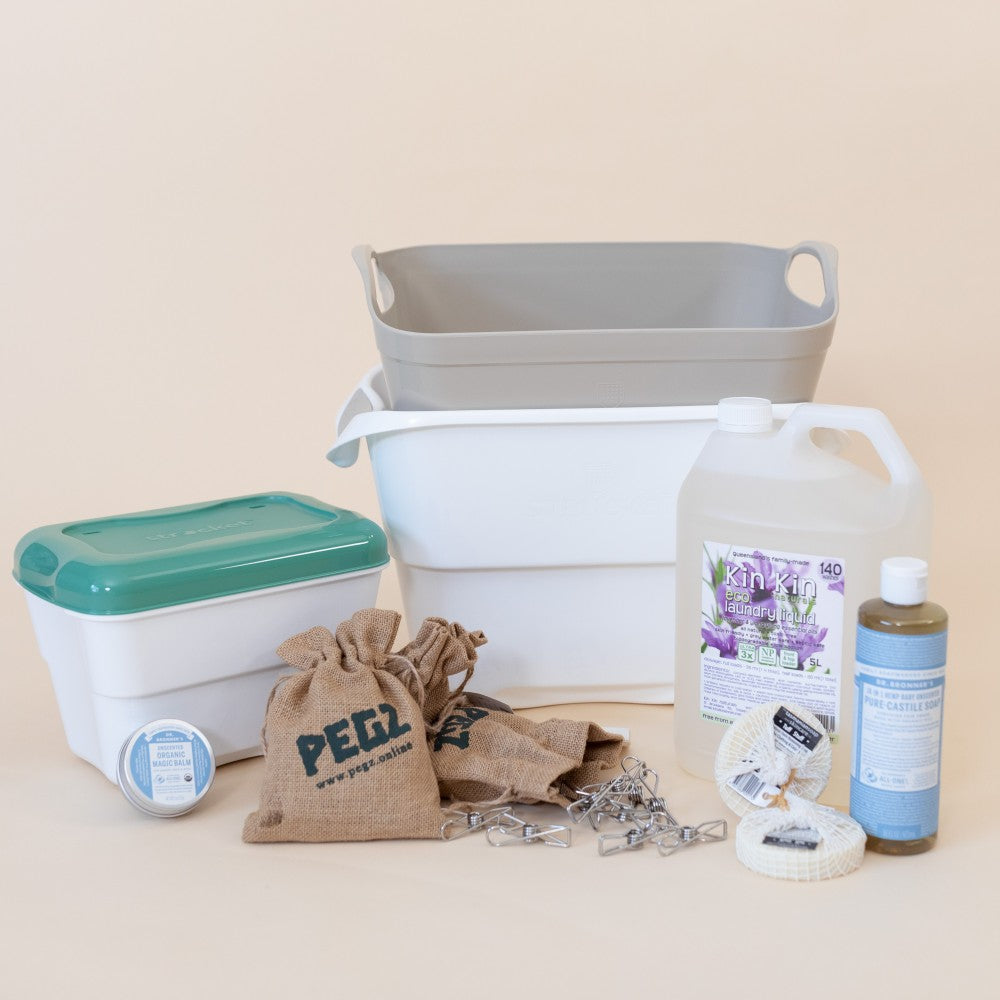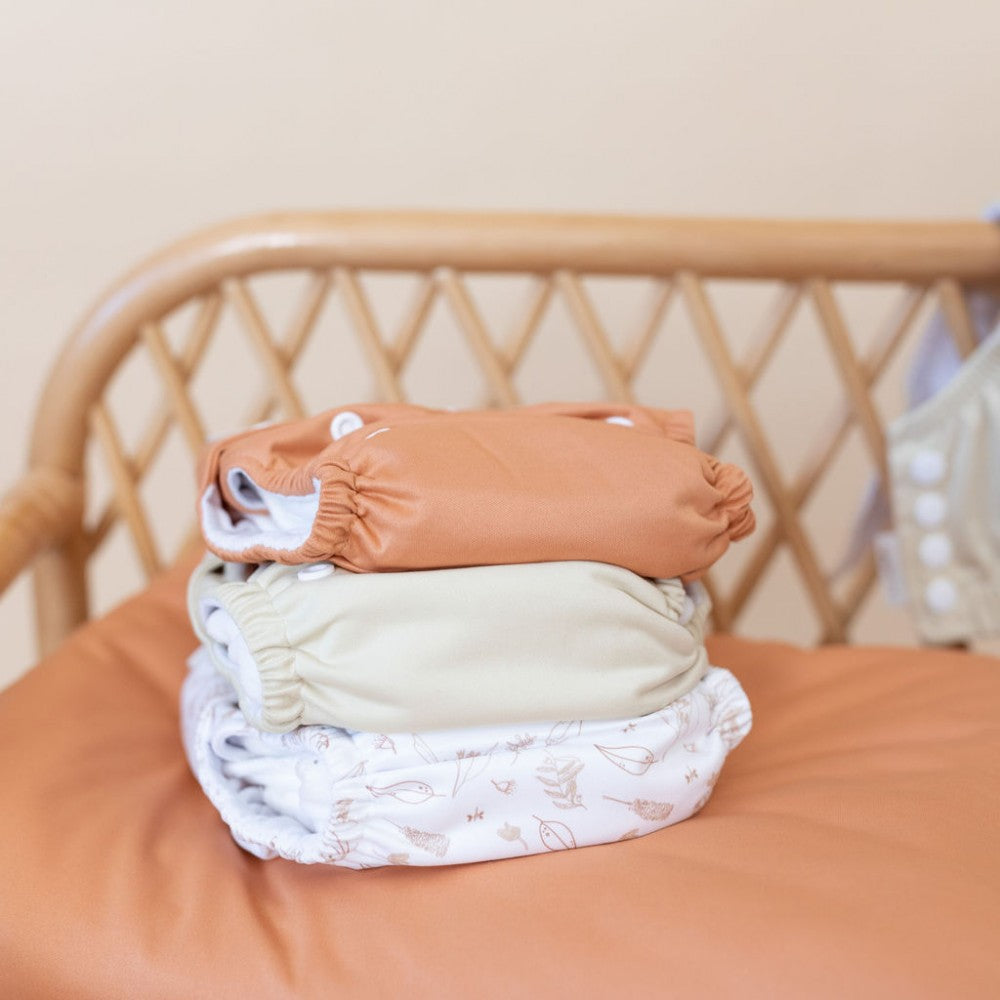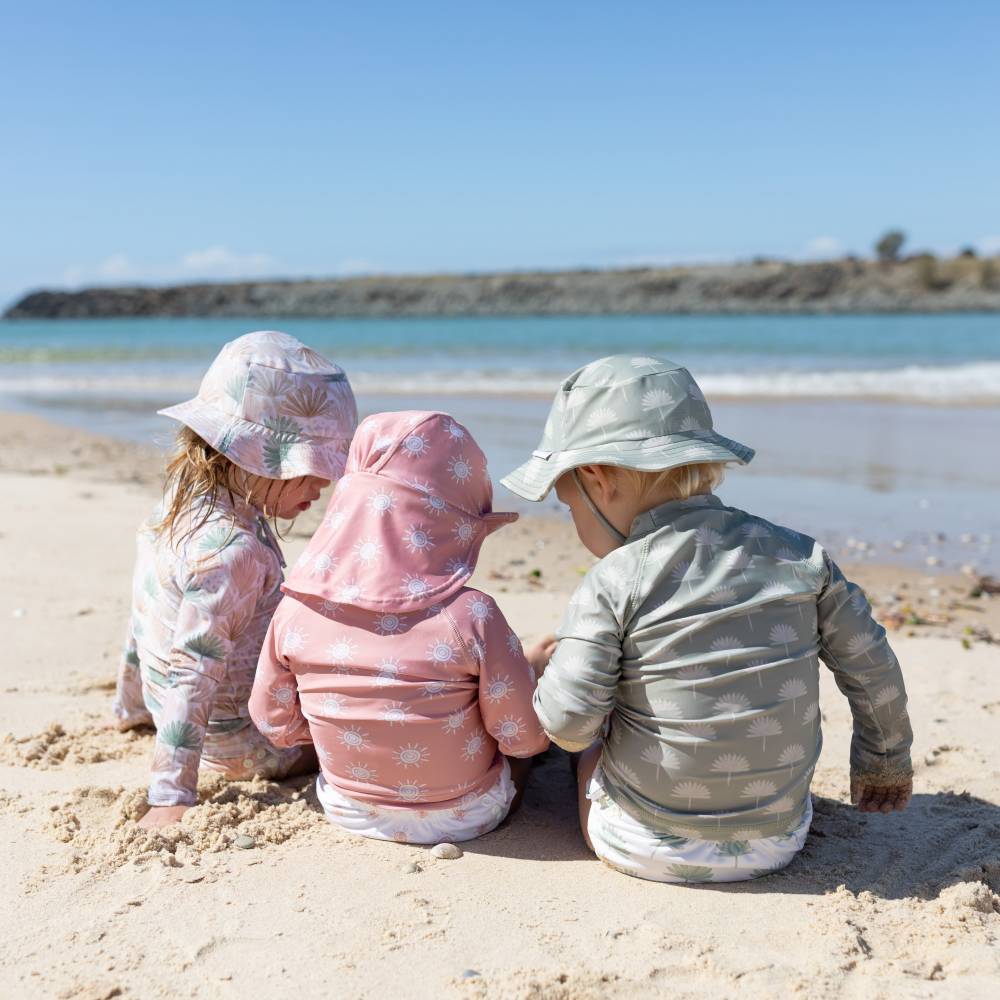With so much information online, it can be hard to nail down exactly what you should and shouldn't be doing when cleaning cloth nappies.
As a modern cloth nappy manufacturer, we've refined a set of steps that work effectively to clean and remove stains as well as extend the life of our nappies. Everybody's wash routine will look slightly different to suit their environment and circumstances, but our steps can be used as a guide.
When washing cloth nappies it's important not to skip any of the steps as it could mean your MCNs become stained, unhygienic and damaged.
Please note: the following steps are for cleaning modern cloth nappies. Please note other styles of cloth nappies like pre-folds will have different washing instructions.

Detergent Choice
Before we get into the steps for how to wash cloth nappies, the first thing you need to choose is your detergent.
We choose to use eco-friendly detergents as these are better for babies' skin and the environment. Our number one choice is the Kin Kin Laundry Liquid because it's natural while still doing a great job of achieving clean cloth nappies.
Since eco-friendly detergents aren't packed full of heavy chemicals, you will find you need to use more detergent to get the same clean result. We've explained further down on quantities for the Kin Kin Lavender Laundry Liquid. For non eco-detergents, follow the instructions by the detergent manufacturer for the correct measurement. Please note your water hardness can also influence which detergent choice works best for you.
Never use fabric softeners or antistatic products in your washing cycles as this can damage your nappies.
If you choose to use a different detergent, check the following:
- Avoid detergents that contain 'fragrance' or 'perfum' in the ingredients as these are synthetic toxic chemicals and pose a number of health risks.
- Avoid detergents that contain bleaching agents, like whiteners or brighteners. These can cause nappy rash and reduce the absorbency of the natural fibres of our inserts.
- Avoid detergents that contain softeners as these will also reduce the usable lifetime of your nappies.
How To Clean Cloth Nappies
Step 1: Remove Excess Soiling & Rinse
When an insert becomes soiled, the first step is to remove as much of the poo as possible into the toilet.
This can be done in a number of ways. If the poo is solid enough you should just be able to shake it into the toilet but if not try the following options.
- Simplify this step by using a disposable liner like our compostable disposable bamboo nappy liners. The liner will capture most of the solid and reduce stains on your inserts.
- Use a bidet if you have one or get a nappy sprayer installed to rinse off soiling directly into the toilet. Nappy sprayers are like a little high-pressure hose that can easily be attached to your external toilet tap with no plumber required.
- Another option is to use a silicone bristled nappy brush. This will help to remove any pancaked soiling when there is no clean shake off.

After you have removed the excess soiling, you can use a natural stain remover like our Tuff Stuff Stain Remover to gently agitate any stains. We recommend this brand of stain remover because it works amazingly well and doesn't damage the cloth nappy inserts like some other stain removers like Napisan. After rinsing and using the stain remover, squeeze out any excess water.
A note on night nappies: If you are using MCNs overnight, give them a good rinse after each change as these are changed less often and so build up more urine and potential ammonia than those used during the day.
Why Complete This Step?
Completing this step first has many benefits including:
- The bacteria in poo and the acidity of wee can start to damage the natural fibres so rinsing first prolongs the life of your nappies.
- Rinsing removes excess soiling which will help with stain removal and cut down on the smell.
- Reduces the amount of poo and subsequent bacteria entering your dry pail and washing machine.

Step 2: Dry Pail Dirty Nappies
The next step is dry pailing your dirty covers and inserts.
A dry pail is simply a dry nappy bucket that is aerated. We use a nappy bucket called the Strucket because it provides an aerated storage environment between washes.
Whichever nappy bucket you choose, make sure it provides adequate airflow. Don't overfill your dry pail as this will not provide adequate aeration. Also, remember to clean your dry pail each time you empty it to kill any bacteria.
Hot tip: It can be useful to have another dry pail so you can separate dirty nappies and prewashed nappies.
We also recommend a plastic nappy bucket over a cane or metal basket. Metal can leave stains on the nappy. Rattan/cane baskets are porous so bacteria from the nappies will harbour in the basket which can be difficult to disinfect.
Never soak your cloth nappies as it will only wear out the nappies, harbour bacteria and mould and an open bucket of water around your home can be a drowning hazard.
Why Complete This Step?
Our nappy inners are made from absorbent natural fibres like bamboo and hemp which can become a breeding ground for bacteria and other nasties when wet, so it's essential we keep them as dry and aerated as possible.
Step 3: Pre Wash Cycle Every 1-2 Days
Add your dirty nappies (both covers and inserts) from the dry pail into your machine for a pre-wash before the main long wash cycle. A pre wash is a short wash cycle that prepares your modern cloth nappies for the long wash.
Whether you wash daily or wash every 2nd day will depend on the age of your baby and whether you're doing part-time or full time cloth.
When: Every 1 - 2 days
Water Temperature: Between 40° - 60°
Duration: 30 to 45 minutes
Detergent: 1/2 recommended dose unless using eco-detergents then use full dose.
Load Size: It doesn't matter how many nappies you add to the machine for your pre wash.
Cycle Type: Ensure the short wash cycle you select includes a rinse, drain and spin.
You can also add in other baby accessories into this wash like your reusable baby wipes, wet bags or change mats.
If NOT doing your main load right away, pop pre-washed nappies into your dry pail until main wash day.
Following the short cycle wash check your covers look and smell clean. If they are, you don't have to add them to your main wash. You cannot skip the main wash for the absorbent fabrics as these absorb liquid and hence need more intensive washing.
A note on temperature: Washing between 40° to 60° will more effectively remove bacteria than using cold water. However, DO NOT wash over 60°. The PUL lining of your covers are heat sensitive, and exposing them to very hot water could cause de-lamination and void your warranty.
Why Complete This Step?
You might be thinking why not just wash cloth nappies all in one go?
The reason for the pre wash is to remove most of the heavy soiling from the nappies, so in the main wash, nappies aren't swirling around in a 'poo and wee soup'. If you went straight to the main wash without pre-washing, the nappies would be washed in dirty water and not be sufficiently cleaned.
Another reason for the pre-wash is that you may not do the main wash for 3 days. The longer urea sits, the more likely it is to turn into ammonia that builds up on your inserts and covers. Ammonia is very irritating to the babies' sensitive skin and will cause nappy rash, redness and, in extreme cases, burns.
Step 4: Main Wash Cycle Every 2 - 3 Days
When you have enough nappies to complete a load it's time to do the main wash cycle.
When: Every 2 -3 days
Water Temperature: Between 40° - 60°
Duration: 2-3 hours
Detergent: Full recommended dose unless using eco-friendly detergents then use double the dose.
Load Size: We recommend loading the machine for best agitation and also protection of nappies, to "loosely full" when dry, which will result in ¾ full when items are wet.
Cycle Type: Choose the cottons/heavy duty cycle if you have this on your machine.
Don't have enough nappies for a full load? You can add in other baby items or family household laundry to bulk the load. Opt for light colours if you're worried about potential colour run. It's best to use smaller items over larger items when combining with household laundry. (E.g. Bed linen/towels can hinder the agitation).

Step 5: Drying
Option 1: Line Drying
Inners:
Nappy inners like our inserts, cloth nappy boosters and trifold nappy inserts should be dried in direct sunlight. Ensure you stretch all wet inners to maximum shape before drying. Slight shrinkage due to the natural fibre inserts will occur.
Since these are the parts that are soiled most heavily, line drying in the sun will expose them to UV, killing off any remaining germs. The sun also acts as a natural bleacher helping to whiten your nappies.
Covers:
Dry your covers in the shade, as direct sunlight will cause them to wear and fade faster. Hang nappies horizontally across the lines to prevent drag on the elastic.
Option 2: Tumble Drying
If you live in cooler areas or areas with prolonged periods of wet weather, you will likely need to use a tumble dryer to dry your nappies.
Inners:
It is safe to tumble dry your inserts, boosters and trifolds on low heat in a dryer.
Covers:
Covers cannot be tumble dried. Tumble drying the covers will damage them.
Our inserts are very absorbent, with many thirsty layers. The downside of this is they take longer to dry. They need to be 100% dry before storing them. Ensure your nappies are completely dry before storing away to stop potential mould or smell.
That's why we recommend having more inserts for when you're still waiting for your last lot of inserts to dry. Having extra supply takes the pressure off your washing turnaround time. Check out our blog 'How Many Cloth Nappies Do I Need?' for more detailed recommendations.
It's up to you how you store your dry nappies, I personally add the inserts to the covers so they're ready to go and store them in an open aerated basket next to our change table.
The Environmental Impact of Cleaning Cloth Nappies
The biggest environmental impact of reusable nappies happens during the washing of cloth nappies. Here are some of the ways our routine reduces this impact:
- Not exceeding 60° as this will use more energy to heat the water.
- Filling the tub loosely full vs only doing small loads will save water.
- Eco plant-based detergents have lower fossil resource depletion compared to synthetic detergents.
- Line dry your nappies when possible vs using a dryer to save on energy usage.
- Use a front loader as they are more water-efficient than top loaders.
For more information on how you can reduce the environmental impact of cloth nappy use, visit our cloth nappy sustainability page.
Mumma & Founder,
Jordan xx
Frequently Asked Questions
- + Can I Add Other Laundry With My Cloth Nappies in the Main Wash?
-
If you don't have enough nappies to fill your machine to get sufficient agitation during the main wash then you can wash your nappies with your other washing. We recommend smaller items like tea towels or dishcloths as larger items like bath towels can reduce the ability for the nappies to rub up against each other to penetrate the deeply embedded urine and soiling.
Note that many clothing items do not need to be washed in warm or hot water like cloth nappies do, so washing your normal clothes together may cause them to shrink and wear out faster.
- + Wouldn't Constantly Washing Nappies at Higher Temperatures Damage Them?
-
As long as you wash your nappies between the recommended 40° - 60° and follow the drying instructions above, your cloth nappies will be fine.
A cold wash will not sufficiently remove soiling and urine. Ammonia build-up due to not washing at the recommended temperatures will be far more damaging to your nappies as it can eat away at the natural fibres or break down the laminate lining on the covers.
- + My Nappies Still Have Stains, Is That Normal?
-
You shouldn't have stained or smelly nappies if you have done the wash routine properly. If you find your nappies aren't completely clean after following the above steps, try some of the following tips:
- Rinse more thoroughly before adding to your dry pail
- Make sure you are using enough detergent or try a different detergent brand (remember our tips on what to avoid in detergent).
- Ensure you are washing in warm to hot water (but not above 60°)
- Ensure you have a big enough load so sufficient agitation is achieved.
- + I Have a Newborn, Do I Need to Rinse & Scrape off the Solids?
-
Since breastfed newborn poo is water soluble, you will not need to scrape it into the toilet (that would be a mission!). You should however still give it a rinse before adding to your dry pail to remove some of the urine.
This step becomes important when your baby starts to eat solids and their poo becomes more solid.
- + Does It Make a Difference Which Washing Machine I Have?
-
Yes it does, larger washing machines often don't create sufficient agitation and some will not have the required cycles.
There are a couple of things to look for if purchasing a new washing machine.
Front loaders are more water-efficient than top loaders, making them more environmentally friendly. A front loader will also heat its own water so you have full control of the wash temperature, unlike top loaders.
It's best to buy a machine with a smaller load capacity as bigger machines will be difficult to fill with nappies every 2 -3 days. The smaller capacity will allow the required agitation to occur between nappies. We recommend 7 - 8.5 kg machines.
We'd also recommend checking the cycles offered. For example, look for a cycle option between 30 - 45 minutes that has a temperature between 40° and 60° as well as a longer cycle option between 2-3 hours that has a temperature between 40° and 60°. Some washing machines may not offer a shorter wash at the required temperature range, so it's always best to do your research.




Leave a comment
All comments are moderated before being published.
This site is protected by hCaptcha and the hCaptcha Privacy Policy and Terms of Service apply.